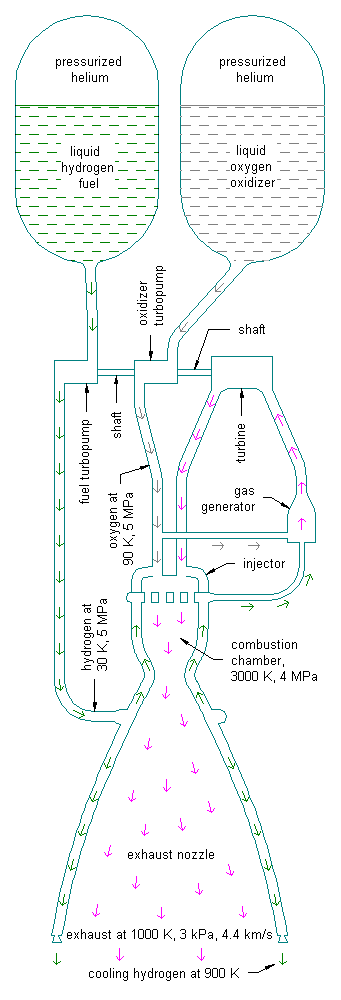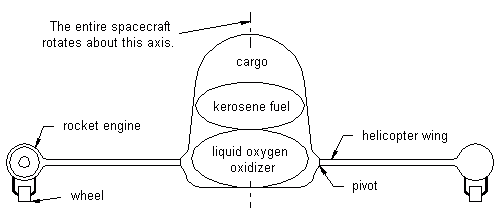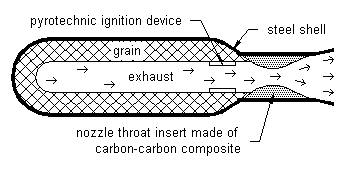CHEMICAL ROCKET LAUNCHER
Gas heated by a chemical reaction provides thrust. Cargo
transported by rockets is called payload. The ratio of cargo mass
to the total mass of the rocket including its cargo and propellant
is called payload fraction. Its value ranges from 6 percent for
liquid propellant rockets to 0.2 percent for solid propellant
rockets. The minimum mass is 10 tons.
DETAILS
If we ignore gravity and aerodynamic drag, the final velocity of
a rocket equals:
V = (exhaust_gas_velocity) natural_logarithm (cargo_mass /
total_mass)
The total_mass includes structural parts, propellant, and
cargo. According to the above formula, which is know as the rocket
equation, a high velocity of exhaust gas is needed to launch
massive cargo. Rocketeers often talk of specific impulse,
which is measured in seconds and is proportional to the exhaust gas
velocity. A specific impulse of one second corresponds with the
exhaust gas velocity of 9.8 m/s. The maximum velocity of the
exhaust gas is about twice its
speed of sound:
Umax =
A0(2/(G-1))0.5
- where:
- A0 is the initial speed of sound of the exhaust
gas
- G is the ratio of specific heat at constant pressure to
specific heat at constant volume
The high exhaust gas velocity calls for a hot gas having low
molecular mass. The extreme temperature of the exhaust gas is the
main cause of the high cost and high failure rate of rocket
launchers. To maximize the specific impulse, some researchers
attempt to build rockets propelled by pure hydrogen heated either
by electric
current, or a laser, or microwaves, or a nuclear reactor.
There are five types of chemical rockets:
- Liquid propellant rockets burn a mixture of liquid fuel and liquid oxidizer, e.g., hydrogen
and oxygen. They have a high specific impulse (350-540 seconds) but
require expensive turbopumps to feed fuel and oxidizer at a high
pressure to the combustion chamber. The thrust-to-weight ratio of
the
Space Shuttle main engine is about 70. Russian NK-33 engine's
thrust-to-weight ratio is approximately 125.

Profile of liquid propellant rocket engine
Roton is a liquid propellant rocket which substitutes
centrifugal force for the expensive turbopumps. The entire rocket
rotates about vertical axis. It looks like the Hero engine,
except that it has helicopter-like blades which provide lift during
flight through the atmosphere. The specific impulse is only 300
seconds because the centrifugal force is too weak to pressurize low
density liquids, e.g., liquid hydrogen.

Roton profile
More information is available at: http://www.rotaryrocket.com/,
http://www.im.lcs.mit.edu/roton/.
Another unique design is the catalytic decomposition rocket
engine. It uses a single chemical: liquid hydrazine. Hydrazine
is very toxic and unstable at high temperatures. In the presence of
a catalyst, hydrazine decomposes into nitrogen, ammonia, and
hydrogen. The specific impulse is 240 seconds. This reliable rocket
engine controls the attitude of communications satellites and the
roll of the upper stages of rocket launchers.
- Solid propellant rockets burn a solid block made of
fuel, oxidizer, and binder (plastic or rubber). The block is called
grain. Ammonium perchlorate oxidizer and other chlorine compounds
are toxic, corrosive, and damage the ozone layer. Ammonium nitrate
oxidizer is hygroscopic, but is usually more desirable, because it
is safe, cheap, and smokeless. Solid propellant rockets are
inexpensive, but have a low specific impulse (200-260 seconds), and
cannot be throttled. In other words, the rocket cannot be stopped;
it burns until all the grain is exhausted. When used in outer
space, they may produce space
junk in the form of micrometer-size aluminum oxide particles
and centimeter-size slag.

Solid propellant rocket profile
- Hybrid rockets burn a mixture
of solid fuel and liquid or gaseous oxidizer, usually synthetic
rubber and oxygen. The rubber is perforated to ensure thorough
mixing of the fuel and oxidizer. Hybrid rockets are exceptionally
safe. They almost match the high specific impulse of liquid
propellant rockets, and require only half the number of expensive
turbopumps. Most designs forgo turbopumps; liquid oxygen is fed
into the combustion chamber by tank pressure.

Hybrid rocket profile
Hybrid
rocket page at AspireSpace.
Hybrid
rocket page at Marshall Space Flight Center.
- Inverse hybrid rockets burn a mixture of solid oxidizer
and liquid or gaseous fuel. They are much less popular than hybrid
rockets because the liquid fuel is highly flammable.
- Pulse detonation rockets periodically detonate a mixture
of liquid fuel and liquid oxidizer in a straight tube that has one
end closed. Because the mixture is injected into the tube at a low
pressure, turbopumps are not needed. Detonations do not bode well
for the durability of these novel rockets. The specific impulse is
about 10 percent higher than that of the liquid propellant
rockets.
BIBLIOGRAPHY
K. K. Kuo and M. Sommerfield, (eds.) Fundamentals of
Solid-Propellant Combustion, AIAA, 1984.
George P.
Sutton, Rocket Propulsion Elements, 5th edition,
Wiley-Interscience, 1986, ISBN 0-471-80027-9.
Y. M. Timnat, Advanced Chemical Rocket Propulsion,
Academic Press, 1987.
Atmospheric Effects of Chemical Rocket Propulsion, AIAA,
1992.
Dieter K. Huzel and David H. Huang, Modern Engineering for
Design of Liquid-Propellant Rocket Engines, AIAA, 1992, ISBN
1-56347-013-6.
- There are four newsgroups devoted to rocket launchers:
- sci.space.shuttle
- sci.space.tech
- sci.space.news
- sci.space.history
- History of rockets:
- W. Von Braun, F. I. Ordway III, and D. Dooling, Space
Travel. A History, Harper and Row, 1995.
- A
brief history of rockets by James M. Dumoulin.
- History of rocket
launchers by Mark Wade.
This site was hosted by the NASA Ames Research Center from 1994-2018 and is now hosted by:


